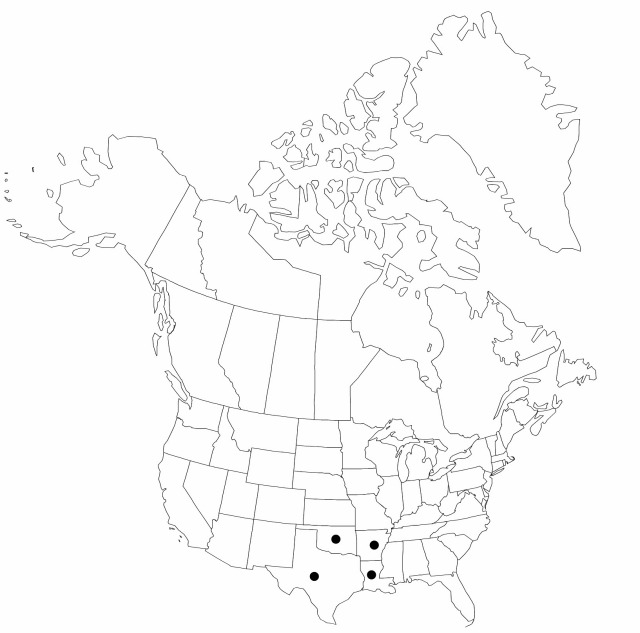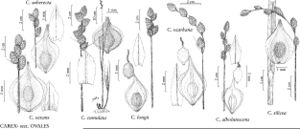Carex ozarkana
Brittonia 48: 104, figs. 1, 2. 1996.
Plants loosely cespitose in small clumps. Culms (35–) 45–95 (–110) cm; vegetative culms inconspicuous. Leaves: sheaths sometimes abaxially green-and-white-mottled near to collar, adaxially green-veined near collar, Y-shaped, white-hyaline area at collar, adaxially firm, summits U-shaped; distal ligules 2–5.5 mm; blades on fertile culms 3–5, 1.5–24 cm × 1.8–4 mm. Inflorescences open or dense, usually nodding or arching, yellowish-brown, 2.3–8.4 cm × 6–17 mm; proximal internode 2.3–16 mm; 2d internode 6–15 mm; proximal bracts bristlelike to 3 cm. Spikes (3–) 5–8 (–9), distant, distinct, conic to globose, 8–19 × 4.2–8.2 mm, base often strongly clavate, apex acute to rounded; staminate portion of well-developed spikes to 11 mm. Pistillate scales yellowish-brown to reddish-brown with green midstripe, lanceolate or narrowly ovate, 3–4 mm, shorter and narrower than perigynia, margins white-hyaline, apex acute to obtuse. Perigynia appressed, pale-yellow or golden brown with green wing and beak, conspicuously 4–6-veined abaxially, conspicuously 4–6 (–7) -veined adaxially, obovate to broadly elliptic, biconvex, 3–4.7 × 1.9–2.8 mm, 0.4–0.5 mm thick, margin flat, including wing 0.5–0.9 mm wide; beak greenish at tip, flat, ciliate-serrulate, abaxial suture with white or reddish brown-hyaline margin, distance from beak tip to achene 1.8–2.7 mm. Achenes elliptic, 1.4–2 × 0.9–1.2 mm, 0.4–0.5 mm thick, 48b apiculum 0.4–0.8 mm; style straight or slightly sinuous. 2n = 62.
Phenology: Fruiting early summer.
Habitat: Seepy stream banks, permanently wet ditches, pond shores, wet depressions in meadows and pastures
Elevation: 100–400 m
Distribution

Ark., La., Okla., Tex.
Discussion
See note under 146. Carex longii.
Selected References
None.
Lower Taxa
"shortened" is not a number."+timesaslongasinflorescences" is not declared as a valid unit of measurement for this property."shorter and narrower" is not a number.
